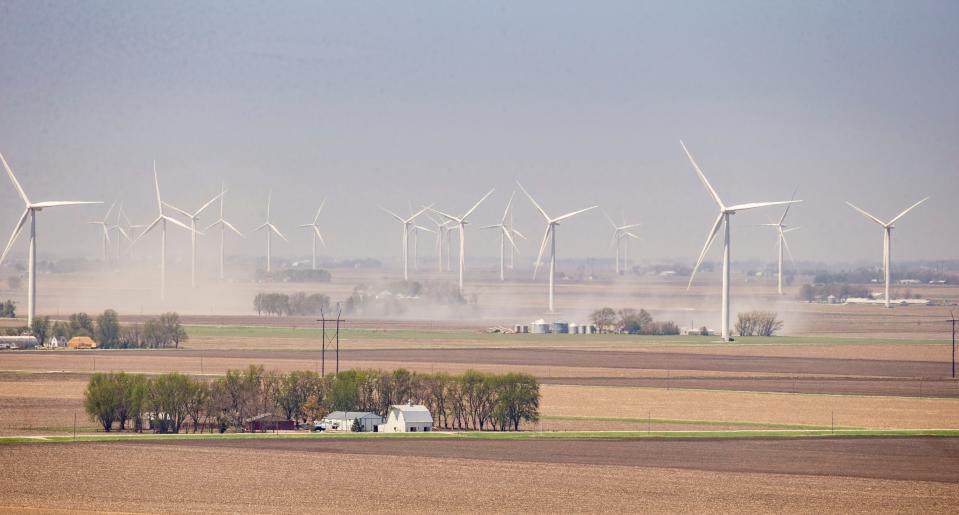MidAmerican can move ahead with its proposed $3.9 billion WindPrime request. But will it?
State regulators approved MidAmerican Energy's proposal to spend $3.9 billion to build more capacity to generate wind and solar energy, but added conditions that environmentalists say better protect consumers and require more analysis on the utility's clean-energy transition.
MidAmerican, the power company owned by Warren Buffett's Berkshire Hathaway, says it can build nearly 2,100 megawatts of wind and solar energy generation at "no net cost to consumers." That's due in part to last year's Inflation Reduction Act, which earmarked $369 billion in tax credits and other support for renewable energy generation that cuts greenhouse gas emissions.
The Iowa Utilities Board approved MidAmerican's plan on Thursday but tacked on new requirements, giving the state's largest utility 20 days to decide whether to accept the plan. MidAmerican's Geoff Greenwood said in an email Monday that the company was evaluating the order to determine its next steps for the project, called WindPrime.
The order excluded MidAmerican's initial plan to also explore emerging technologies such as carbon capture and small modular nuclear reactors. They were dropped in an earlier settlement proposal.

Attorneys for the Iowa Environmental Council, the Environmental Law & Policy Center and the Sierra Club said MidAmerican could ask the utilities board to reconsider its order.
The order, which allows MidAmerican to build 2,042 megawatts of wind and 50 megawatts of solar generation, requires the company to annually verify that the project comes at no added cost to consumers. The utilities board reduced the financial return to MidAmerican from 11.25% to 9.5%.
Even with a healthy financial return, the company anticipates customers would bear no costs with the project, given federal tax credits provided through the Inflation Reduction Act and clean energy sales, said Michael Schmidt, an Iowa Environmental Council attorney.
In fact, MidAmerican would share potential profits with customers, under the order.
MidAmerican also would be required within 24 months to assess its plan to reach zero carbon emissions, under a resource evaluation study.
The analysis could drive MidAmerican to look at adding more solar and battery storage in the future and consider retiring its coal plants earlier, Josh Mandelbaum, an Environmental Law & Policy attorney, said Monday in a call with reporters.
The groups have pushed MidAmerican to retire at least three coal-fired power plants and replace them with a mixture of wind, solar and battery storage, a move that would save consumers money and reduce Iowa's greenhouse gas emissions, the groups say.
MidAmerican has said its "Destination Net Zero" plan includes retiring its five coal-fired power plants by 2050. Doing it sooner would reduce the company's ability to reliably provide energy, it said.
Environmental groups forced MidAmerican to release an internal "zero emission study" that Mandelbaum said "helped the board conclude that solar generation is better situated to meet MidAmerican's reliability needs over the long term."
The utilities board said in the order that the "lack of decommissioning of coal generation from theMidAmerican portfolio mitigates" the carbon dioxide benefits from adding new wind and solar generation.
Environmentalists say wind and solar generation is complementary. Solar energy production peaks during the day, and wind often peaks at night. And seasonally, wind generation is stronger in winter and solar in summer.
MidAmerican's wind generation would climb to 67% with the WindPrime project. It now accounts for 61% of the company's energy generation, according to the order.
MidAmerican powered 88.5% of its customers' energy needs with renewable energy in 2021.
At nearly 60%, Iowa leads the nation in its share of energy that comes from wind generation, according to the Energy Information Administration.
President Joe Biden has set a national goal to cut in half greenhouse emissions that contribute to global warming by 2030.
Donnelle Eller covers agriculture, the environment and energy for the Register. Reach her at deller@registermedia.com or 515-284-8457.
This article has been corrected to say that exploring emerging technologies had been dropped from MidAmerican's plan.
This article originally appeared on Des Moines Register: MidAmerican gets green light to build $3.9 billion in new wind, solar

